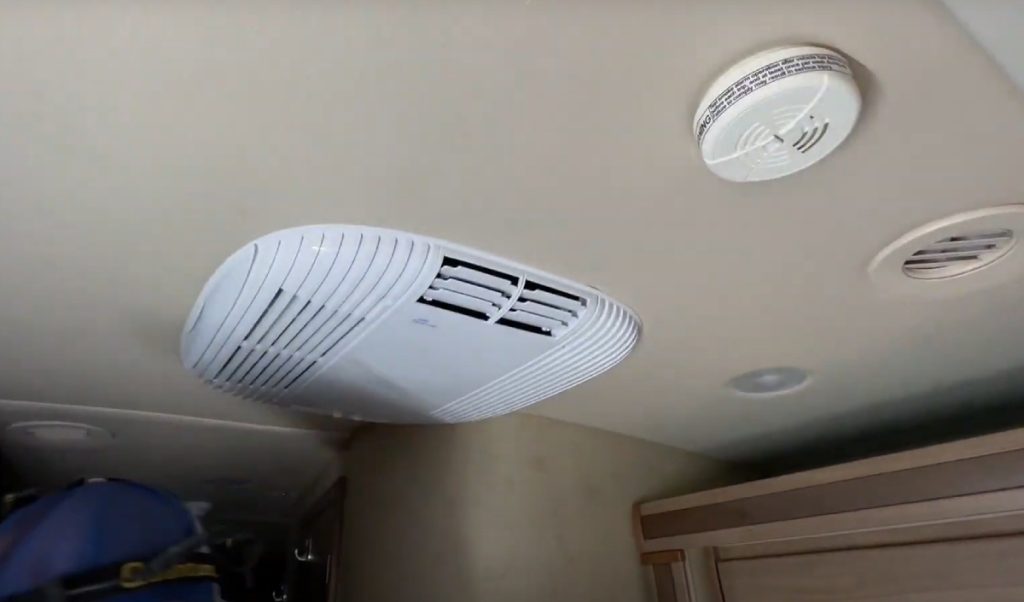Last Updated on September 16, 2024
To install your RV air conditioner, select a unit with the right capacity, ideally around 15,500 BTU. Then, safely disconnect power to the old unit and remove it, noting wire connections with pictures. Clean the installation area with assistance before lifting the new unit into place.
Secure wiring connections following color codes and install a duct divider to optimize airflow. Make certain all seals are tight to prevent leaks and improve efficiency. Finally, a maintenance routine must be set up to keep the system running smoothly. There’s much more to cover for a successful installation process.
Key Takeaways
- Select an appropriate AC unit, typically around 15,500 BTU, ensuring high energy efficiency and reputable sourcing.
- Safely disconnect power, referencing photos for wiring, and remove the old unit by unbolting it from the rooftop.
- Enlist help to lift and position the new AC unit, ensuring even weight distribution and using safety gear.
- Connect wiring according to color codes, and secure connections tightly to avoid electrical issues.
- Properly seal the installation site and duct divider to prevent air leaks and enhance cooling efficiency.
Choosing the Proper Air Conditioning Unit for Your RV
Understanding your cooling needs is essential when choosing an RV air conditioner. Start by contemplating the common capacities available, such as 13,000 BTU, 15,000 BTU, and 18,000 BTU.
For most RV sizes, selecting the right AC unit with a capacity of around 15,500 BTU, like the Furrion Chill model, guarantees adequate cooling while maintaining efficiency. Additionally, models like the Coleman Mach 15+ offer quick installation and high performance, making them a great choice for hot climates.
Efficiency is a critical factor to evaluate. An efficient unit not only cools your space effectively but also minimizes energy consumption, saving you money on power bills. Look for features that enhance performance, such as high SEER ratings or energy-saving modes.
While focusing on functionality, don’t overlook the importance of design. An appealing AC unit can enhance the aesthetics of your RV’s interior. When you’re ready to purchase, prioritize reputable sources that provide product links. This simplifies your selection process and guarantees you’re getting a quality unit.
Preparing for Installation
It is important to prepare adequately before starting the installation process to guarantee a smooth and efficient setup. Start by confirming that the AC unit and the 12-volt power are turned off to prevent electrical hazards.
Once that’s done, carefully disconnect the existing wires. Taking a reference picture of their configuration; that’ll make reconnection much easier later on.
Next, remove the old AC unit, typically secured by four bolts. After you’ve removed it, clean the surrounding area to improve the efficiency of your new installation. Don’t forget to check and seal all openings around the installation site to prevent air leaks that can compromise the performance of your new AC unit.
Before proceeding, gather all necessary tools and materials. This will streamline your workflow and guarantee that everything is readily available when you need it.
Always use the right tools to avoid damaging your RV or the new unit. By following these steps, you’ll set yourself up for a successful installation and minimize potential issues that could arise later.
Disconnecting Power Safely
Turning off both the RV’s air conditioner and the 12-volt power is essential to guarantee a safe installation process. This step prevents electrical hazards while you work on the unit.
Begin by locating the air conditioner’s power switch and the 12-volt system’s main circuit breaker. Turn them off, making sure no power flows to the AC.
Next, use a multimeter to double-check that all power sources are completely turned off. This extra precaution helps confirm that you can proceed without risk.
Once you’ve verified the power is off, you can safely disconnect the power wires from the old AC unit. It’s a good idea to take a reference picture of the wiring configuration for correct reconnection later.
Always use insulated tools to minimize the risk of shocks and short circuits when handling electrical connections. Be mindful of loose wires and make certain they’re secured out of the way.
Removing the Old Unit From Your RV
After turning off the power and taking the necessary precautions, you’re ready to remove the old AC unit. Begin by disconnecting the wires connected to the unit. Before you do this, take a reference picture to ensure you can reconnect everything correctly later.
Next, locate the four bolts that secure the old AC unit to the rooftop. Use a socket wrench to carefully remove these bolts. Once they’re out, you can gently lift the unit off its mounting. Be cautious, as the unit may be heavier than it appears.
After successfully removing the old unit, clean the surrounding area thoroughly. This step is essential as it enhances your new unit’s efficiency and prevents debris from interfering with installation.
Lifting the New AC
Lifting the new AC unit onto the roof requires careful planning and teamwork. Start by enlisting someone to help you handle and maneuver the unit safely. Use a sturdy rope to lift the AC unit, ensuring it’s securely attached. Avoid dragging it across the surface, as this can cause damage.
Position the unit directly over the designated hole to streamline the installation process. Maintaining even weight distribution is crucial; it’ll help prevent strain and potential injury. Always wear appropriate safety gear, including gloves and a harness, while working on the roof.
Here’s a quick reference table for your lifting process:
| Step | Action | Safety Tip |
|---|---|---|
| 1. Prepare | Gather tools and safety gear | Make sure everything is within reach |
| 2. Secure the Unit | Attach a sturdy rope | Check for wear on the rope |
| 3. Lift Together | Use even lifting technique | Communicate clearly with your partner |
| 4. Position | Align AC over the hole | Double-check alignment before releasing |
Wiring Connections
Begin by connecting the 120V AC wires using color-coded standards: black for hot, white for neutral, and green or bare for ground. This guarantees safety and proper functionality. Make secure connections by twisting and crimping the wires together, and always verify that the connections are tight to prevent electrical issues.
For thermostat connections, you’ll need four wires: one for positive, one for negative, and two additional wires labeled A and B. Confirm these are connected correctly for accurate temperature control. When integrating the heating and cooling systems, connect the furnace control wires (red and white) to the AC unit’s brown wires.
Lastly, tuck all wiring neatly away to minimize any airflow restrictions. Keeping the wiring organized not only maintains the air conditioning unit’s peak performance but also reduces the risk of damage or disconnections during operation.
Installing the Duct Divider
Installing the duct divider is essential for separating the return and cooled air, ensuring ideal temperature control in your RV. To maximize your air conditioning system‘s efficiency, ensure it’s securely fastened and insulated to prevent air leakage.
Importance of Duct Divider
When optimizing your RV’s air conditioning system, the significance of a duct divider can’t be overstated. This component is essential for separating the return air and cooled air within the ductwork, ensuring proper airflow while maintaining temperature comfort throughout your RV.
By preventing the mixing of airflows, the duct divider enhances cooling efficiency and reduces the risk of your AC unit freezing up, delivering effective cooling performance. Proper installation of the duct divider is crucial. Using insulation to cover any air gaps boosts efficiency and minimizes noise from airflow.
Furthermore, sealing holes or gaps around the duct divider with foil tape creates a solid barrier, further improving your cooling system’s overall performance. A well-installed duct divider also provides flexibility in temperature control. When needed, you can open vents for rapid cooling, quickly adapting to your comfort requirements.
Installation Tips and Techniques
A well-installed duct divider plays a key role in maintaining your RV’s air conditioning efficiency, and getting it right during installation is vital. Start by positioning the duct divider correctly to separate the return air from the cooled air. This separation is essential for temperature comfort and overall efficiency.
| Step | Action | Purpose |
|---|---|---|
| Positioning | Align the divider accurately | Guarantees proper airflow separation |
| Insulation | Cover gaps with insulation | Prevents energy loss |
| Securing | Fasten the divider firmly | Avoids air mixing |
| Sealing | Use foil tape for gaps | Enhances airflow efficiency |
After securing the duct divider, regularly inspect it to confirm its integrity. Look for any signs of wear that could affect airflow and cooling effectiveness.
Ensuring Proper Seals
Ensuring proper seals around your RV air conditioner is essential for ideal performance and comfort. Any gaps can lead to air leaks, reducing efficiency and increasing energy costs.
Importance of Sealing
Proper sealing around your RV air conditioner is vital to maintaining efficiency and minimizing energy costs. When air leaks occur, your unit must work harder, resulting in increased energy consumption and discomfort during travel. A secure seal not only enhances airflow but also prolongs the lifespan of your AC system.
Here are three key reasons why sealing is important:
- Energy Efficiency: Tight seals prevent air leaks, so your AC unit runs efficiently, saving you money on energy bills.
- Comfort: Proper sealing guarantees consistent temperature control, reducing frustrating fluctuations that can make your RV uncomfortable.
- Longevity: Regularly maintaining seals can avert potential leaks, extend the life of your AC unit, and enhance your overall RV experience.
To achieve effective sealing, tighten bolts to 40-50 foot-pound torque, guaranteeing a secure fit between the AC unit and the roof.
Common Sealant Types
Selecting the right sealant is vital for achieving effective seals around your RV air conditioner. Common options include silicone, polyurethane, and butyl tape, each with unique properties that cater to different needs.
Silicone sealants are popular due to their exceptional waterproofing capabilities and resistance to temperature fluctuations. They are ideal for outdoor applications and provide a reliable seal that effectively withstands the elements.
Polyurethane sealants offer strong adhesion and durability, perfect for sealing larger gaps. Their robustness guarantees a long-lasting barrier against weather-related wear, enhancing the integrity of your installation.
Butyl tape is a versatile, self-adhesive, and simple-to-apply option. It’s commonly used to secure AC units to the roof, creating a reliable barrier against moisture and air leaks.
Optimizing Airflow
To achieve ideal airflow in your RV air conditioning system, keeping the return air and cooled air separated within the ductwork is crucial. This separation helps maintain temperature comfort and prevents freezing, guaranteeing your system runs efficiently.
Here are three critical actions you should take:
- Check for Obstructions: Regularly inspect your ductwork for any blockages. Even small obstructions can notably reduce your cooling efficiency, leaving you uncomfortable on hot days.
- Use Duct Dividers: Install insulated duct dividers to cover air gaps effectively. This prevents the mixing of return and cooled air, enhancing the overall performance of your AC system.
- Seal with Foil Tape: Apply foil tape to seal any holes or gaps in the ductwork. This guarantees smooth airflow and minimizes energy loss, helping your system run at its best.
Routine Maintenance Tips
Regularly clean the filters to maintain ideal airflow and enhance the unit’s overall performance to keep your RV air conditioner running efficiently. Proper maintenance can also greatly extend the lifespan of your RV air conditioner, similar to how regular upkeep is essential for best RV water pumps of 2025. Inspect the seals around the unit and ductwork to prevent air leaks that can drive up energy costs.
Regular Filter Cleaning
Regular filter cleaning is crucial for maintaining the efficiency and performance of your RV air conditioner. Neglecting this task can reduce airflow and increase energy costs.
To keep your air conditioner running smoothly, follow these maintenance tips:
- Clean or Replace Filters Every 1-3 Months: This guarantees peak airflow and efficiency, especially during peak usage periods.
- Use a Vacuum or Mild Soap: Remove dust and debris buildup from the filters with a vacuum or a solution of mild soap and water. Always verify they’re completely dry before reinstalling.
- Document Maintenance Schedules: Keep a log of filter maintenance in your RV maintenance records to track upkeep and prolong the lifespan of your air conditioning system. During summer months or when you frequently use your RV, check the filters more often.
Inspect Seals Regularly
How often do you check the seals around your RV air conditioner? Regular inspections are vital for ensuring ideal performance and preventing air leaks.
Start by examining all seals for uniform compression and the absence of gaps. Compromised seals can greatly impact cooling efficiency, so assessing the weather stripping on the air distribution box is important for any signs of wear or damage.
Schedule routine maintenance every six months to catch potential seal issues before they escalate into more serious problems. Use a flashlight for a thorough inspection, ensuring the seals are intact and securely attached to both the roof and the air conditioning unit.
After heavy rain or storms, make it a habit to inspect the seals quickly. This will help you identify any compromise that could lead to water leaks, protecting your RV’s interior.
Monitor Airflow Performance
Maintaining ideal airflow performance is essential for your RV air conditioner’s efficiency and cooling effectiveness. To guarantee your AC unit is effectively cooling your space, follow these routine maintenance tips:
- Inspect Airflow: Regularly check the temperature difference between the return and supply vents. A considerable difference indicates proper cooling.
- Maintain Filters: Clean or replace air filters monthly, especially during peak usage. This prevents dust buildup, which can restrict airflow and reduce efficiency.
- Measure Static Pressure: Use a manometer or airflow meter to measure static pressure in the duct system. Confirm it stays within the manufacturer’s recommended range for peak performance.
Frequently Asked Questions
Are All RV Air Conditioners the Same Size?
No, not all RV air conditioners are the same size. They typically come in standard BTU ratings like 13,000, 15,000, and 18,000, which cater to different cooling needs based on your RV’s size and insulation.
How Long Does It Take to Replace an RV AC Unit?
Replacing an RV AC unit usually takes 2 to 4 hours. You’ll need about 30 minutes for prep, 1 to 2 hours for installation, and an additional 30 minutes to check everything’s working properly.
Can You Run RV AC on the House Plug?
Yes, you can run an RV AC on a house plug, but ensure the outlet can handle the required amperage. Always check the manufacturer’s specifications and use a heavy-duty extension cord if needed.
Can You Add an AC Unit to an RV?
Absolutely, you can add an AC unit to your RV. Just make certain your electrical system supports the load and that the roof can handle the weight. Proper sealing and maintenance are essential for peak performance.
Stay Cool All Summer Long: Maximizing Your RV Air Conditioner’s Performance
Now that you’ve successfully installed your RV air conditioner imagine those hot summer days ahead. Will your new unit keep you cool and comfortable?
It should, with proper sealing and airflow optimization. But don’t forget to schedule routine maintenance to guarantee it runs efficiently. The real test is just around the corner. Are you ready to enjoy a revitalizing escape whenever you hit the road? Your comfort depends on it.



